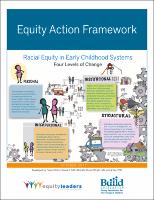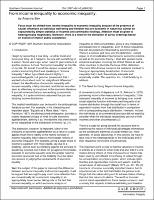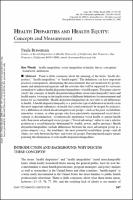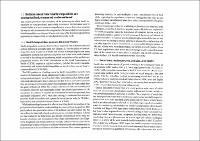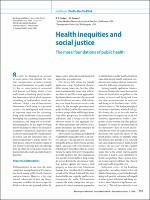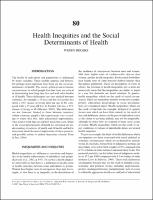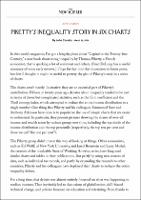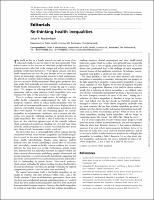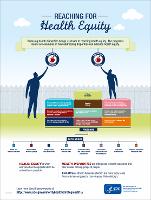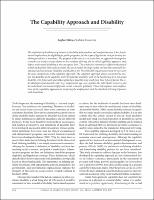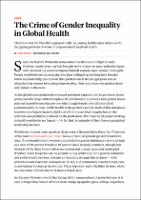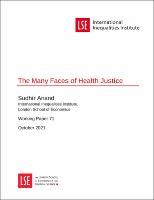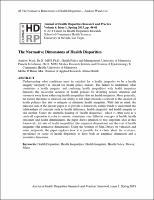Browsing 1.01.01 Inequality vs Inequity by Title
Now showing items 6-25 of 29
-
Equality of What?
(Cambridge: Cambridge University Press., 1979)
Well-being is not just a question of the wealth or pleasure that a person has; it is a question of how people manage to live their lives and the ability they have to do certain things that are important to them. This was the argument put forward by Professor Amartya Sen in 1979. In his seminal Tanner Lecture – ‘Equality of What?’, Sen unites economics and philosophy to explore how a person’s well-being might best be measured. It was the first in a series of writings in which he developed his capability approach. This focuses on the actual capability ... -
Equity Action Framework
(2017)
Th e Equity Action Framework1 is designed to support individuals and groups that want to advance racial equity in early childhood systems. Th e goal of a racial equity approach is to develop policies, practices, and programs that provide opportunities, promote fairness and access, and remediate racial inequities. Whether working at national, state, county, or municipal levels of government, in private-public partnerships, community organizations, foundations or other entities, the Equity Action Framework provides an intentional process for ... -
Equity Action Framework
(Race forward, 2009) -
From income inequality to economic inequality.
(Southern Economic Journal, 1997)
Focus must be shifted from income inequality to economic inequality because of the presence of causal influences on individual well-being and freedom that are economic in nature but cannot be expounded by simple statistics of incomes and commodity holdings. Attention must be given to heterogeneous magnitudes. Moreover, there is a need for the derivation of partial orderings based on explicit or implicit public acceptance. -
HEALTH DISPARITIES AND HEALTH EQUITY: Concepts and Measurement
(Annual Review of Public Health, 2006)
There is little consensus about the meaning of the terms “health disparities,” “health inequalities,” or “health equity.” The definitions can have important practical consequences, determining the measurements that are monitored by governments and international agencies and the activities that will be supported by resources earmarked to address health disparities/inequalities or health equity. This paper aims to clarify the concepts of health disparities/inequalities (used interchangeably here) and health equity, focusing on the implications of ... -
Health inequalities: critical perspectives
(Oxford University Press, 2016)
This section provides a brief summary of the main ways in which health in-equalities are conceptualized, particularly in terms of the indicators used to stratify health. It is by no means a comprehensive account but rather considers the ways in which researchers focusing on the UK have tended to conceptualize health inequalities over the past 30 years and some of the key chalenges to these approaches (critiques which are developed later in this book). -
Health inequities and social justice: The moral foundations of public health
(Bundesgesundheitsblatt - Gesundheitsforschung - Gesundheitsschutz, 2008)
Recently we argued that social justice is concerned with human well-being, which is best understood as involving plural, irreducible dimensions, each of which represents something of independent moral significance. Health is one of these distinct dimensions of well-being, as is personal security, the development and exercise of cognitive capacities for reasoning, living under conditions of social respect, developing and sustaining deep personal attachments, and being able to lead self-determining lives. In this paper, we address why considerations ... -
Health Inequities and the Social Determinants of Health
(John Wiley & Sons, Ltd, 2006)
The health of individuals and populations is influenced by many variables. These include genetics and biology, but perhaps more important than these are the social determinants of health. The social, political and economic circumstances in which people live their lives are critical in determining how long they live and with what burden of ill health. These differences are very marked between countries, for example a 15-year-old boy in Lesotho has about a 10% chance of living until the age of 60, compared with a 15-year-old boy in Sweden who has ... -
Health, Disability and the Capability Approach: An Introduction
(Journal of Human Development and Capabilities, 2015)
This special issue of the Journal of Human Development and Capabilities focuses on two areas of substantial and growing importance to the human development and capability approach: disability and health. The research on disability, health and the capability approach has been diverse in the topics it covers, and the conceptual frameworks and methodologies it uses, beginning over a decade and a half ago in health (Ruger 1998) and more than a decade ago in disability (Baylies 2002).1 We are pleased to share a set of articles in these two areas. ... -
HEALTH, VITAL GOALS, AND CENTRAL HUMAN CAPABILITIES
(Bioethics, 2013)
I argue for a conception of health as a person’s ability to achieve or exercise a cluster of basic human activities. These basic activities are in turn specified through free-standing ethical reasoning about what constitutes a minimal conception of a human life with equal human dignity in the modern world. I arrive at this conception of health by closely following and modifying Lennart Nordenfelt’s theory of health which presents health as the ability to achieve vital goals. Despite its strengths I transform Nordenfelt’s argument in order to ... -
Piketty’s Inequality Story in Six Charts
(The New Yorker, 2014) -
Re-thinking health inequalities
(Oxford University Press on behalf of The European Journal of Public Health, 2020-06-19) -
Reaching for Health Equity
(US CDC, 2016) -
Regional strategy on health system strengthening and primary health care
(Manila : WHO Regional Office for the Western Pacific, 2010) -
RESPONSIBILITY FOR HEALTH AND HEALTH CARE
(Oxford University Press 2005) -
The Capability Approach and Disability
(JOURNAL OF DISABILITY POLICY STUDIES)
The definition of disability is of interest to disability policymakers and analysts because it has fundamental implications for eligibility for public programs, for the scope of legislation, and for the way disability prevalence is measured. The purpose of this article is to assess how an approach developed in economics to analyze issues related to the standard of living, the so-called capability approach, may help us understand disability at the conceptual level. The article first summarizes different theoretical models of disability (the ... -
The Concern for Health Equity
(Oxford University Press 2004, 2004) -
The Crime of Gender Inequality in Global Health
(Voice-Foreign Policy) -
The Many Faces of Health Justice
(The London School of Economics and Political Science, October 20)
This paper develops the idea of health justice as a plural conception. It draws on the literature on justice from philosophy and economics, and investigates its application and reach in the space of health. Several distinctions are invoked in identifying and contrasting different facets of health justice and injustice. These include active versus passive injustice; process fairness versus substantive justice; comparative versus noncomparative justice; compensatory and distributive justice. Within distributive justice, the health implications of ... -
The Normative Dimensions of Health Disparities
(Journal of Health Disparities Research and Practice, 2013)
Understanding what conditions must be satisfied for a health inequality to be a health inequity (disparity) is crucial for health policy makers. The failure to understand what constitutes a health inequity, and confusing health inequalities with health inequities threatens the successful creation of health policies by diverting needed attention and resources away from addressing health inequalities that are health inequities. More generally, the failure threatens to undercut our ability to tell what research is relevant to the creation of health ...


